10 Myanmar Traditional Arts
- Panbe ( the art of blacksmith )
- Panbu ( the art of sculpture )
- Pantain ( the art of gold and silver smith )
- Pantin( the art of bronze casting )
- Pantaut ( the art of making floral designs using masonry )
- Panyan ( the art of bricklaying and masonry )
- Pantamault ( the art of sculpting with stone )
- Panpoot ( the art of turning designs on the lathe )
- Panchi ( the art of painting )
- Panyun ( the art of making lacquer ware )
Besides the above arts there are
- Pottery
- Mosaic
- Tapestry
- Lapidary
- Lotus Textile Weaving
- Gold Foil Making
- Silversmith
- Wooden Parquetry
- Wall Painting
- Silk Weaving
- More about Lacquerware
as Myanmar traditional arts.
Panbe ( the art of blacksmith )
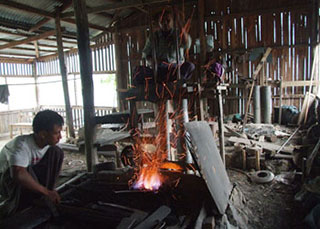
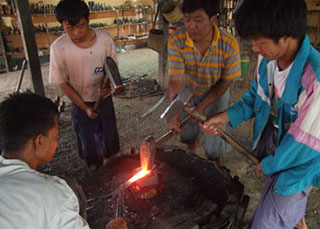
The art of Panbe ( black smith ) is the tempering of iron in the furnace to make necessary items. The artisans make ox cart axle. ox cart iron. tyre. scissors. hammer. adze. pickaxe. knife. hatchet. axe. digging hoe and mattock. The Myanmar’s traditional blacksmith craft emerged in the early of Bagan period (11th century A.D) and it had improved in the mid Bagan Ava and Yadanapon period. Myanmar’s traditional blacksmith craft. from Inlay region were famous in the Yadanapon period.Many types of blacksmith craft articles are available. such as military armour. weapons. file. pickaxe. mattock. hoe sword. etc. The Myanmar’s traditional blacksmith craft is very famous in the South East Asia and constitute one of the artistic wonders of the world.
Panbu ( the art of sculpture )
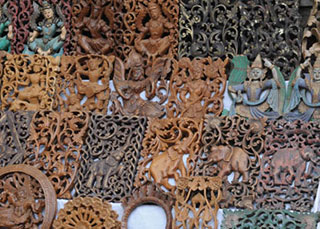

The art of Panbu ( Sculpture ) means the one which produces figures and floral designs made of wood or ivory. The artisans make the figure of human beings and animals and floral designs. Myanmar’s traditional sculpture emerged before the Bagan period and it improved in the middle of Bagan Era. Myanmar’s sculpture base the religion of Buddhism which arrived from Southern India in the 11th century A.D.Most of the wood sculptures of Bagan and Ava periods have been lost under various circumstances and only a few are left today. One outstanding wood sculpture belonging to the Bagan period is the one at the old portal of Shwesigone pagoda at Nyaung-U. Those who want to see wood sculptures of Yatanapon (Mandalay) or latter Yadanapon periods should visit following places:
Shwe-inbin Monastery. Mandalay
Bakaya Monastery. Inwa
Myanmar’s traditional sculpture contains wood sculpture stone sculpture and plaster sculpture but more wood sculptures will be seen in many arts and crafts shops. in many cities of Myanmar. The wood sculptures are liked by many people in the world to-day.
Pantain ( the art of gold and silver smith )
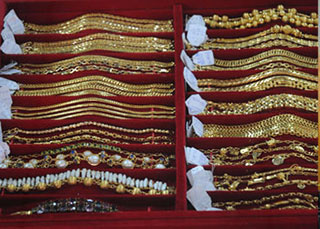
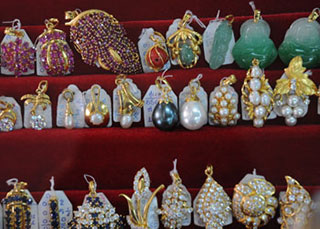
The art of Pantain ( gold or silver smith ) is an enterprise of making items of gold or silver. Silver smith is the art of making drinking bowl. receptacle bowl. prize-cup. shield and belt. Gold smith is the art of making ear-plug. ear-drops. ear-ring. with a screw-on back piece. finger-ring bracelet . Pendent and necklace. Myanmar’s traditional arts and crafts artistic creation of gold and silver wares come under the genre (ba-dain) art of making items in gold or silver. Creating silverware had been with Myanmar for the past one thousand two hundered years. and judging from the workmanship of the silverware that belong to those early years. it is indeed something for the Myanmar’s to crow about. According to the crystal palace chronicles. during the reign of King Anawrahta the relices of Buddha and the three repositories of Buddhist scriptures were brought to Bagan from Suvunna Boumi. the mon capital. along with them came mon artisans and works of mon arts and crafts. gold and silverware etc. Going further back into the past. we find Pyu silver works of art discovered from the mounts of old shrines of Sri Ksetra.
Pantin ( the art of bronze casting )
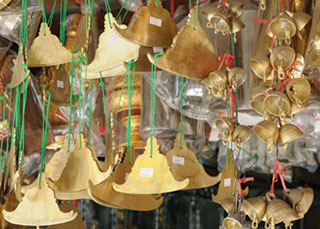
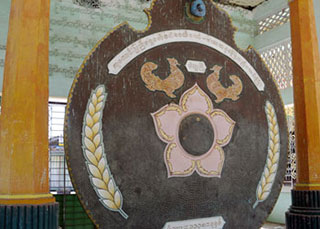
The art of Pantin is an enterprise producing materials of copper. bronze or brass. The artisans make triangular brass gong. gong. and brass bowl for monk. weights in the shape of brainy ducks. tray. copper pot. cup bowl. cymbal. bell jingle bell and small brass gong. Myanmar’s traditional coppersmith’s craft emerged before Bagan period and it improved during Bagan and Ava period. Every pagoda in Myanmar has bells. which were struck to tell the people of good deeds done. They are triangular bells which twirl when struck and ring with a sweet rising and falling tone. which gradually fades away. Moreover there are gongs. slung from carved ivory or wood elephant trunks. which are prized as dinner gongs. Different sizes and shapes of bells. all unmistakably Burmese in design. are popular as souvenirs. So are other castings such as weights and cow bells.
Pantaut ( the art of making floral designs using masonry )

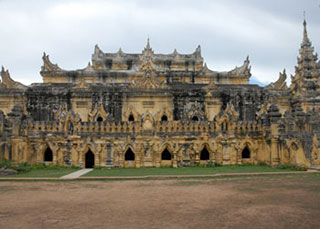
The art of Pantaut ( stucco sculpture ) means a handicraft of making decorative floral designs in relief with stucco. The artisans make the figures of lions. dragons and floral designs with stucco. Myanmar traditional stucco carving emerged before the Bagan period and it improved in the Bagan. Ava. Amarapura and Yadanapon period. According to the historical records. Stucco works were very famous in Bagan period. Stucco works of Bagan period have detailed decorations. After Bagan we had Stucco carvings of mid-Konbaung or Amarapura period. which are very Burmese in style and very fine. The curled leaves and buds. though few. look very beautiful. The buds and flowers in bunches in the centre of the portal at U Kin-danke are unique. Menu’s brick monastery at Ava stands magnificently today with wooden pyathad durrets above it. The great building itself is a work of art to command our admiration.
Panyan ( the art of bricklaying and masonry )
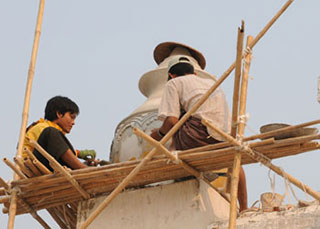
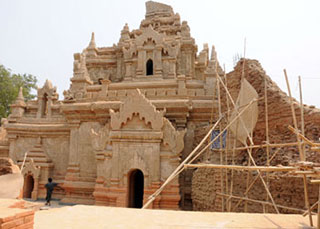
The art of Panyan ( mason ) is an enterprise which constructs the buildings using bricks. stones and cement. The masons build brick houses. Pagoda. bridges. Myanmar’s traditional masonry works enjoys world wide renown for the ancient Pagodas and other religious buildings around the Bagan region. The Myanmar’s traditional masonry of Bagan period is the highest developed of all the historical periods. Their works are remarkable for their strength. grandeur beauty of form. immensity of volume. detailed and appropriate decorations and the power to hold the spectators in awe. The masonry of mid Amarapura period is beautiful and lively but to be placed only in the second order. behind Bagan. The Myanmar’s traditional masonry have derived from the mon’s culture of Suvanna Bhumi and in the Southern Indian’s culture flun the 11th century A.D. In Fact – Masonry in Myanmar emerged since the Pyu period in the 1st century A.D.
Pantamault ( the art of sculpting with stone )
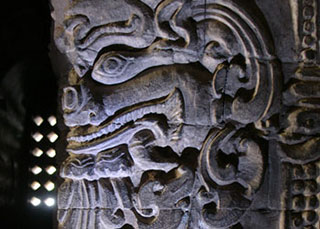
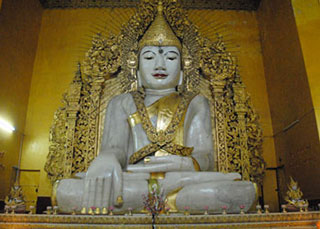
The art of Pantamault ( stone sculpture ) is the one stones curving. The artisans make Buddha images pole for sima. pillar. leograph. elephants. deer. circular flat stone. pestle and mortar and table. Sculpture in stone is a significant feature of Myanmar fine arts. has to this day been the pride and honour of Myanmar people. There are sculpture studios or workshops in Yangon. Mandalay and other towns in the country. but the majority of studios are concentrated in Mandalay. Very fine works of art in stone are to be seen at plaques depicting the life of the Buddha at Ananda. Bagan. Flower designs in the interior of the portal at Kyawkku-U min. Naung-U Nanhpaya. Myinkapa plaques partraying the 550 Buddhist birth-stories at Puhtotawkyi. Amarapura and the great image at Kyauktawkyi. at the foot of Mandalay Hill.
Panpoot ( the art of turning designs on the lathe )
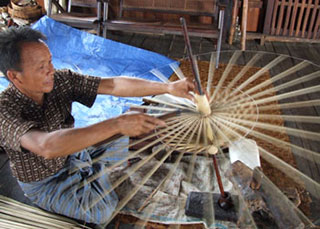
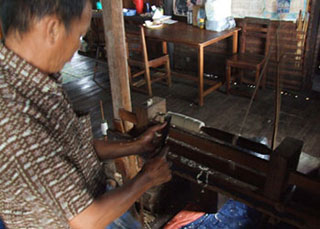
The art of Panpoot is an enterprise to make wooden utensils turning on turners lathe. Such as making shaft of umbrella. table legs. and legs of bed and turnery posts for Pavilions and railings. Myanmar’s traditional crafts of a turner emerged in the Bagan period in the 8th century A.D. The craft of a turner is an art which is made by rubbing the woods on the turner’s lathe. Craft of a turner artists based on the traditional styles of Bagan. Ava and Yatanapon period. Besides that. Myanmar’s craft of a turner artists is very interesting. Diversity in the shape of the craft of a turner. food containers. boxes. bowls. taunglon tables. chairs etc. all makes them attractive. The Myanmar’s traditional arts and crafts owed a great deal of influence of Mon. the people of suvanna Bhumi-artists and artisans the Southern India’s culture in the early Bagan period.
Panchi ( the art of painting )
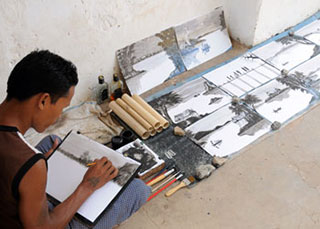

The art of Panchi ( painting ) is the one which illustrates living animals and inanimate objects using different colours. The artists paint the figures of human beings. animals. objects. scenery designs and cartoons. Myanmar traditional painting developed with the religion of Buddhism in the Bagan Region. Thus. Bagan become a repository of ancient Myanmar traditional paintings and sculptures in the 11th century A.D. Because of Myanmar artist’s achievements. we have more paintings of Konbaung period than those of Ava. they are more colourful and lively. During Yadanapon of Mandalay period more painting was done in folding books called purapaik and on canvas than on the wall. The wall paintings at Mahamuni Pagoda in Mandalay were executed in later Yadanapon period. Most of these paintings have been copied and collected by the Archaeological Department. Myanmar.
Panyun ( the art of making lacquer ware )

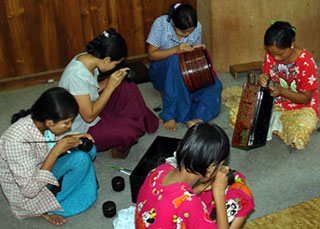
The art of Panyun ( Lacquerware ) means a handicraft which produces materials made of bamboo. wood and thick black varnish (sis-se). Lacquerware artisans produce alms food bowl. bowl for monk. and bowl of pickle tea. lacquer vessel. drinking cup. betel box. and cheroot box. Myanmar traditional lacquerware emerged in the early part of Bagan period. Myanmar traditional lacquer ware drawing styles derived from many stories of Buddha’s life. Burmese lacquerware is one such product. whose art goes back to the 11th century. On a framework of woven. finely cut strips of bamboo. mixtures of thit-see resin with clay and ash are carefully built-up and finally polished with the ash of fossil wood. The designs are then etched or painted by hand. The most traditional Burmese lacquerware is of a unique terracotta colour. with scenes from the jatakas. the Buddha’s former existence. etched and then filled in with green pigment. More modern designs are in deep. velvet black. with simpler figures laid on in gennine gold leaf. Many types of Burmese lacquerware articles are available. such as boxes. vases. trays. bowls and even coffee tables. Bagan. site of the architectural wonders of the East. is the home of this craft.
